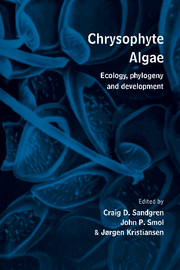Book contents
- Frontmatter
- Contents
- Preface
- List of contributors
- 1 History of chrysophyte research: origin and development of concepts and ideas
- Part I Phylogeny, systematics and evolution
- Part II Development, physiology and nutrition
- Part III Ecology, paleoecology and reproduction
- 9 Chrysophyte blooms in the plankton and neuston of marine and freshwater systems
- 10 Biogeography of chrysophytes in Finnish lakes
- 11 The distribution of chrysophytes along environmental gradients: their use as biological indicators
- 12 The influence of zooplankton herbivory on the biogeography of chrysophyte algae
- 13 Application of chrysophytes to problems in paleoecology
- Part IV Contributed original papers
- Index of scientific names
- Subject index
9 - Chrysophyte blooms in the plankton and neuston of marine and freshwater systems
Published online by Cambridge University Press: 05 March 2012
- Frontmatter
- Contents
- Preface
- List of contributors
- 1 History of chrysophyte research: origin and development of concepts and ideas
- Part I Phylogeny, systematics and evolution
- Part II Development, physiology and nutrition
- Part III Ecology, paleoecology and reproduction
- 9 Chrysophyte blooms in the plankton and neuston of marine and freshwater systems
- 10 Biogeography of chrysophytes in Finnish lakes
- 11 The distribution of chrysophytes along environmental gradients: their use as biological indicators
- 12 The influence of zooplankton herbivory on the biogeography of chrysophyte algae
- 13 Application of chrysophytes to problems in paleoecology
- Part IV Contributed original papers
- Index of scientific names
- Subject index
Summary
Introduction
Excessive accumulations of algae in freshwater lakes and coastal marine environments have been observed for centuries. Homer's Illiad mentions discoloration of the sea, and the Bible contains a reference to ‘the bloodied waters of the Nile’. Charles Darwin apparently observed a ‘red tide’ off the coast of Chile, and North American Indians would not eat shellfish from ‘shining waters’ based on previous experiences with algal-bloomrelated shellfish poisonings (Red Tide Newsletter 3(2), April 1990). Among the causes most often cited are enrichment of aquatic systems with nutrients from human activities (Vallentyne 1974; Smayda & White 1990). While there is strong evidence that excessive supply of nitrogen and phosphorus and other nutrients is often the underlying cause of algal blooms, it is also clear that bloom development depends upon the coming together, in appropriate combination, of a number of critical biotic, physical and chemical environmental factors (Paerl 1988).
The implication of the early historical evidence of algal blooms is that the consequences of accelerated human population growth and contemporary urbanization and industrialization activities cannot be the only causative factors for algal blooms. For example, there were especially intense blooms of the dinoflagellate Alexandrium cantenella off the Norwegian coast in 1988, which may have been in response to abnormally high water temperatures. Paleo-oceanographic evidence (B. Dale, University of Oslo, unpublished data) suggests that similar blooms developed as far back as 2000 years ago when human-induced influences were undoubtedly negligible.
- Type
- Chapter
- Information
- Chrysophyte AlgaeEcology, Phylogeny and Development, pp. 181 - 213Publisher: Cambridge University PressPrint publication year: 1995
- 21
- Cited by



